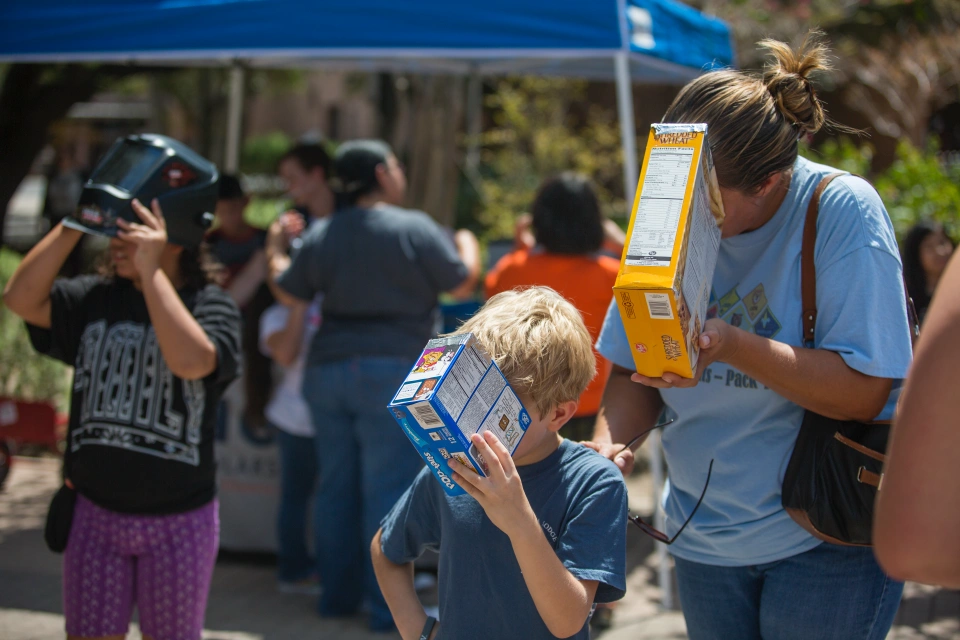Dr. Lorena Flores-Hernandez, optometrist and glaucoma specialist at the UT Health RGV Vision Center, says looking at the last total eclipse of the 21st century on April 8 without special eclipse glasses can cause a “solar burn” in the center of the retina. She shares key guidelines to be safe when observing this natural wonder. (UTRGV Video by Karen Villarreal)
Vision experts urge caution when viewing natural wonder
Thursday, March 28, 2024
Community, Health
By Karen Villarreal
RIO GRANDE VALLEY, TEXAS – MARCH 28, 2024 – If you plan to watch the last total eclipse of the 21st century on April 8, you should take some critical precautions to protect your eyes, as looking at the sun without the proper protection can permanently damage your eyes.
Dr. Lorena Flores-Hernandez, optometrist and glaucoma specialist at the UT Health RGV Vision Center, said looking at the eclipse without those special eclipse glasses can cause a “solar burn” in the center of the retina.
“The inner layers of the retina hold all the cells that we have to see. The macula – where our central eyesight comes from – would get the most damage,” she said. “It can lead to central vision loss, distorted vision and changes in color.”

Still, it’s easy enough to be safe when you’re out there checking out the historic eclipse – just keep a few key guidelines in mind.
“The last time we had full totality in our area was about 100 years ago, and then next time you experience this will be 2044,” Flores-Hernandez said. “It's awesome. You really want to capture it. But, be safe.”
VISION SAFETY TIPS FOR THE ECLIPSE
Flores-Hernandez says the most important thing is to wear eclipse glasses from a reputable company throughout the entire eclipse. Regular sunglasses, or even prescription sunglasses, just won’t be enough.
“They don’t have the filter required to protect your eyes,” she said. “Even welder’s goggles have to be of a certain thickness – a shade level of 14.”
However, eclipse glasses that meet the international safety standard (ISO 12312-2) are readily available.

If you have an older pair on hand, though, check them for defects.
“You want to make sure that there's no scratches or holes on the actual foils of the glasses,” Flores-Hernandez said. “Once there's a wrinkle or a tear, you need to get a new pair.”
Cell phone cameras or other devices with lenses, like telescopes, also could be damaged by the eclipse.
“It can ruin the optics in your actual lens,” she said. “There are filters that you can buy for your cell phone or camera so that the lens doesn't get cracked.”
She also advises being mindful of where you are looking when you put on eclipse glasses or attach lenses to your devices.
“Don't look at the sun and put them on after!” she said.
Instead, Flores-Hernandez says, look straight ahead. Put them on, make sure they're secure – and then look.
“And when you're going to remove them, look away from the sun and then remove them when you’re looking straight ahead.”

She said precautions for babies, children and pets are critical.
“If you're going to have your children outdoors for an eclipse, remember that they're a lot less likely to keep their eclipse glasses on,” she said. “If you think there’s a risk they’re not, it's better to keep them indoors.”
There are other safe ways for children to observe the eclipse indirectly to avoid risking exposure, like pinhole devices, or watching the shadows made by trees.
“That's how we would watch them when my kids were smaller,” Flores-Hernandez said.
“And pets will look where they want – but they do have a retina and central macula, as well,” Flores-Hernandez said. “Maybe keep them indoors or under a covered area.”
WHEN IS THE ECLIPSE?
In the Rio Grande Valley, the eclipse will start about noon, with maximum coverage expected about 1:30 p.m.
“Totality will be the only time that, technically, you can take the glasses off safely – but we won't get full totality in the Valley,” Flores-Hernandez said. “You're going to have to keep them on here throughout the eclipse.”
The UTRGV Planetarium will host a viewing event, April 8 at the Sundial on the Edinburg Campus.
ABOUT UTRGV
The University of Texas Rio Grande Valley (UTRGV) was created by the Texas Legislature in 2013 as the first major public university of the 21st century in Texas. This transformative initiative provided the opportunity to expand educational opportunities in the Rio Grande Valley, including a new School of Medicine and a School of Podiatry, and made it possible for residents of the region to benefit from the Permanent University Fund – a public endowment contributing support to the University of Texas System and other institutions.
UTRGV has campuses and off-campus research and teaching sites throughout the Rio Grande Valley including Brownsville (formerly The University of Texas at Brownsville campus), Edinburg (formerly The University of Texas-Pan American campus), Harlingen, Weslaco, McAllen, Port Isabel, Rio Grande City and South Padre Island. UTRGV, a comprehensive academic institution, enrolled its first class in the fall of 2015; the School of Medicine welcomed its first class in the summer of 2016, and the School of Podiatric Medicine in the fall of 2022.
